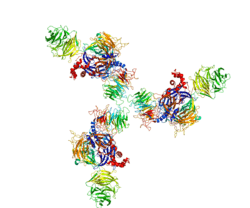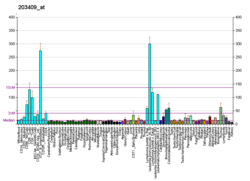DDB2
DNA damage-binding protein 2 is a protein that in humans is encoded by the DDB2 gene.[4][5]
Structure
As indicated by Rapić-Otrin et al. in 2003,[6] the DDB2 gene is located on human chromosome 11p11.2, spans a region of approximately 24 – 26 kb and includes 10 exons. The DDB2 protein contains five putative WD40 repeats (sequences of about 40 amino acids that can interact with each other) positioned downstream from the second exon. The WD40 motif identified in DDB2 is characteristic of proteins involved in the recognition of chromatin proteins. The C-terminal region of DDB2 (a 48 kDa molecular weight protein) is essential for binding to DDB1 (a larger 127 kDa protein). Together, the two proteins form a UV-damaged DNA binding protein complex (UV-DDB).[7]
Deficiency in humans
If humans have a mutation in each copy of their DDB2 gene, this causes a mild form of the human disease xeroderma pigmentosum, called XPE.[6] Patients in the XPE group have mild dermatological manifestations and are neurologically unaffected. Mutation in the DDB2 gene causes a deficiency in nucleotide excision repair of DNA. This deficiency is also mild, showing 40 to 60% of normal repair capability and a modest sensitivity to UV light in comparison to the sensitivities of cells defective in the other XP genes XPA, XPB, XPC, XPD, XPF and XPG.[8]
Function
Binding to damaged DNA
As shown by Wittschieben et al.,[9] when DDB2 is in a complex with DDB1, forming the heterodimer DDB, this complex binds strongly to DNA containing one type of UV light-induced photoproduct [the (6-4) photoproduct], to DNA with an abasic site, to DNA containing mismatches without a covalent lesion, and to “compound” lesions containing both mismatches and lesions. The heterodimer DDB binds with intermediate strength to DNA containing another UV light-induced photoproduct (the cyclobutane pyrimidine dimer), and binds weakly to DNA that has no DNA damage. The DDB2 component of the heterodimer contains the specificity for binding to damaged DNA, since a heterodimer DDB complex containing amino acid substitutions in the DDB2 subunit, as found in XP-E patients, is very deficient in binding to damaged DNA. DDB1 and DDB2, each acting alone, do not bind DNA.
Chromatin remodeling
The packaging of eukaryotic DNA into chromatin presents a barrier to all DNA-based processes that require recruitment of enzymes to their sites of action. To allow the critical cellular process of DNA repair, the chromatin must be relaxed.
DDB2, in its heterodimeric complex with DDB1, and further complexed with the ubiquitin ligase protein CUL4A[10] and with PARP1[11] rapidly associates with UV-induced damage within chromatin, with half-maximum association completed in 40 seconds.[10] The PARP1 protein, attached to both DDB1 and DDB2, then PARylates (creates a poly-ADP ribose chain) on DDB2 that attracts the DNA remodeling protein ALC1.[11] Action of ALC1 relaxes the chromatin at the site of UV damage to DNA. This relaxation allows other proteins in the nucleotide excision repair pathway to enter the chromatin and repair the DNA damaged by the UV-induced presence of cyclobutane pyrimidine dimers.
Other functions
In 2015, Zhu et al.[12] showed that DDB2 down-regulates the acetylation of lysine 56 in histone H3 (H3K56Ac) after UV-induced DNA damage through DDB2 interaction with histone deacetylases 1 and 2. Decreased acetylation of histones decreases transcription of associated genes in the DNA wrapped around the histones.
In 2016, Zou et al.[13] showed that DDB2 is involved in cell cycle arrest and homologous recombinational DNA repair after cells are subjected to ionizing radiation.
In 2016, Christmann et al.[14] showed that exposure of cells to the carcinogenic benzo(a)pyrene metabolite BPDE caused prompt and sustained upregulation of DDB2. This contributed to enhanced removal of BPDE adducts from DNA.
In 2017, Fantini et al.[15] showed that DDB2, in association with XRCC5 and XRCC6 (otherwise known as Ku80 and Ku70, which make up the Ku heterodimer), has transcriptional activities. The DDB2/Ku effects on transcription are separate from the actions of the Ku heterodimer in non-homologous end joining DNA repair.
References
- GRCh38: Ensembl release 89: ENSG00000134574 - Ensembl, May 2017
- "Human PubMed Reference:". National Center for Biotechnology Information, U.S. National Library of Medicine.
- "Mouse PubMed Reference:". National Center for Biotechnology Information, U.S. National Library of Medicine.
- Keeney S, Chang GJ, Linn S (October 1993). "Characterization of a human DNA damage binding protein implicated in xeroderma pigmentosum E". The Journal of Biological Chemistry. 268 (28): 21293–300. PMID 8407967.
- Dualan R, Brody T, Keeney S, Nichols AF, Admon A, Linn S (September 1995). "Chromosomal localization and cDNA cloning of the genes (DDB1 and DDB2) for the p127 and p48 subunits of a human damage-specific DNA binding protein". Genomics. 29 (1): 62–9. doi:10.1006/geno.1995.1215. PMID 8530102.
- Rapić-Otrin V, Navazza V, Nardo T, Botta E, McLenigan M, Bisi DC, Levine AS, Stefanini M (July 2003). "True XP group E patients have a defective UV-damaged DNA binding protein complex and mutations in DDB2 which reveal the functional domains of its p48 product". Human Molecular Genetics. 12 (13): 1507–22. doi:10.1093/hmg/ddg174. PMID 12812979.
- Rapić-Otrin V, McLenigan MP, Bisi DC, Gonzalez M, Levine AS (June 2002). "Sequential binding of UV DNA damage binding factor and degradation of the p48 subunit as early events after UV irradiation". Nucleic Acids Research. 30 (11): 2588–98. doi:10.1093/nar/30.11.2588. PMC 117178. PMID 12034848.
- Rapić Otrin V, Kuraoka I, Nardo T, McLenigan M, Eker AP, Stefanini M, Levine AS, Wood RD (June 1998). "Relationship of the xeroderma pigmentosum group E DNA repair defect to the chromatin and DNA binding proteins UV-DDB and replication protein A". Molecular and Cellular Biology. 18 (6): 3182–90. doi:10.1128/mcb.18.6.3182. PMC 108900. PMID 9584159.
- Wittschieben BØ, Iwai S, Wood RD (December 2005). "DDB1-DDB2 (xeroderma pigmentosum group E) protein complex recognizes a cyclobutane pyrimidine dimer, mismatches, apurinic/apyrimidinic sites, and compound lesions in DNA". The Journal of Biological Chemistry. 280 (48): 39982–9. doi:10.1074/jbc.M507854200. PMID 16223728.
- Luijsterburg MS, Goedhart J, Moser J, Kool H, Geverts B, Houtsmuller AB, Mullenders LH, Vermeulen W, van Driel R (August 2007). "Dynamic in vivo interaction of DDB2 E3 ubiquitin ligase with UV-damaged DNA is independent of damage-recognition protein XPC". Journal of Cell Science. 120 (Pt 15): 2706–16. doi:10.1242/jcs.008367. PMID 17635991.
- Pines A, Vrouwe MG, Marteijn JA, Typas D, Luijsterburg MS, Cansoy M, Hensbergen P, Deelder A, de Groot A, Matsumoto S, Sugasawa K, Thoma N, Vermeulen W, Vrieling H, Mullenders L (October 2012). "PARP1 promotes nucleotide excision repair through DDB2 stabilization and recruitment of ALC1". The Journal of Cell Biology. 199 (2): 235–49. doi:10.1083/jcb.201112132. PMC 3471223. PMID 23045548.
- Zhu Q, Battu A, Ray A, Wani G, Qian J, He J, Wang QE, Wani AA (June 2015). "Damaged DNA-binding protein down-regulates epigenetic mark H3K56Ac through histone deacetylase 1 and 2". Mutation Research. 776: 16–23. doi:10.1016/j.mrfmmm.2015.01.005. PMC 5053336. PMID 26255936.
- Zou N, Xie G, Cui T, Srivastava AK, Qu M, Yang L, Wei S, Zheng Y, Wang QE (October 2016). "DDB2 increases radioresistance of NSCLC cells by enhancing DNA damage responses". Tumour Biology. 37 (10): 14183–14191. doi:10.1007/s13277-016-5203-y. PMC 6528175. PMID 27553023.
- Christmann M, Boisseau C, Kitzinger R, Berac C, Allmann S, Sommer T, Aasland D, Kaina B, Tomicic MT (December 2016). "Adaptive upregulation of DNA repair genes following benzo(a)pyrene diol epoxide protects against cell death at the expense of mutations". Nucleic Acids Research. 44 (22): 10727–10743. doi:10.1093/nar/gkw873. PMC 5159553. PMID 27694624.
- Fantini D, Huang S, Asara JM, Bagchi S, Raychaudhuri P (January 2017). "Chromatin association of XRCC5/6 in the absence of DNA damage depends on the XPE gene product DDB2". Molecular Biology of the Cell. 28 (1): 192–200. doi:10.1091/mbc.E16-08-0573. PMC 5221623. PMID 28035050.
Further reading
- El-Deiry WS (2003). "Transactivation of repair genes by BRCA1". Cancer Biology & Therapy. 1 (5): 490–1. doi:10.4161/cbt.1.5.162. PMID 12496474.
- Qian YW, Wang YC, Hollingsworth RE, Jones D, Ling N, Lee EY (August 1993). "A retinoblastoma-binding protein related to a negative regulator of Ras in yeast". Nature. 364 (6438): 648–52. doi:10.1038/364648a0. PMID 8350924.
- Taunton J, Hassig CA, Schreiber SL (April 1996). "A mammalian histone deacetylase related to the yeast transcriptional regulator Rpd3p". Science. 272 (5260): 408–11. doi:10.1126/science.272.5260.408. PMID 8602529.
- Nichols AF, Ong P, Linn S (October 1996). "Mutations specific to the xeroderma pigmentosum group E Ddb- phenotype". The Journal of Biological Chemistry. 271 (40): 24317–20. doi:10.1074/jbc.271.40.24317. PMID 8798680.
- Hayes S, Shiyanov P, Chen X, Raychaudhuri P (January 1998). "DDB, a putative DNA repair protein, can function as a transcriptional partner of E2F1". Molecular and Cellular Biology. 18 (1): 240–9. doi:10.1128/mcb.18.1.240. PMC 121483. PMID 9418871.
- Martinez E, Palhan VB, Tjernberg A, Lymar ES, Gamper AM, Kundu TK, Chait BT, Roeder RG (October 2001). "Human STAGA complex is a chromatin-acetylating transcription coactivator that interacts with pre-mRNA splicing and DNA damage-binding factors in vivo". Molecular and Cellular Biology. 21 (20): 6782–95. doi:10.1128/MCB.21.20.6782-6795.2001. PMC 99856. PMID 11564863.
- Chen X, Zhang Y, Douglas L, Zhou P (December 2001). "UV-damaged DNA-binding proteins are targets of CUL-4A-mediated ubiquitination and degradation". The Journal of Biological Chemistry. 276 (51): 48175–82. doi:10.1074/jbc.M106808200. PMID 11673459.
- Sun NK, Kamarajan P, Huang H, Chao CC (February 2002). "Restoration of UV sensitivity in UV-resistant HeLa cells by antisense-mediated depletion of damaged DNA-binding protein 2 (DDB2)". FEBS Letters. 512 (1–3): 168–72. doi:10.1016/S0014-5793(02)02250-0. PMID 11852074.
- Tan T, Chu G (May 2002). "p53 Binds and activates the xeroderma pigmentosum DDB2 gene in humans but not mice". Molecular and Cellular Biology. 22 (10): 3247–54. doi:10.1128/MCB.22.10.3247-3254.2002. PMC 133779. PMID 11971958.
- Rapić-Otrin V, McLenigan MP, Bisi DC, Gonzalez M, Levine AS (June 2002). "Sequential binding of UV DNA damage binding factor and degradation of the p48 subunit as early events after UV irradiation". Nucleic Acids Research. 30 (11): 2588–98. doi:10.1093/nar/30.11.2588. PMC 117178. PMID 12034848.
- Bergametti F, Sitterlin D, Transy C (July 2002). "Turnover of hepatitis B virus X protein is regulated by damaged DNA-binding complex". Journal of Virology. 76 (13): 6495–501. doi:10.1128/JVI.76.13.6495-6501.2002. PMC 136256. PMID 12050362.
- Bontron S, Lin-Marq N, Strubin M (October 2002). "Hepatitis B virus X protein associated with UV-DDB1 induces cell death in the nucleus and is functionally antagonized by UV-DDB2". The Journal of Biological Chemistry. 277 (41): 38847–54. doi:10.1074/jbc.M205722200. PMID 12151405.
- Sun NK, Lu HP, Chao CC (November 2002). "Overexpression of damaged-DNA-binding protein 2 (DDB2) potentiates UV resistance in hamster V79 cells". Chang Gung Medical Journal. 25 (11): 723–33. PMID 12553360.
- Groisman R, Polanowska J, Kuraoka I, Sawada J, Saijo M, Drapkin R, Kisselev AF, Tanaka K, Nakatani Y (May 2003). "The ubiquitin ligase activity in the DDB2 and CSA complexes is differentially regulated by the COP9 signalosome in response to DNA damage". Cell. 113 (3): 357–67. doi:10.1016/S0092-8674(03)00316-7. PMID 12732143.
- Rapić-Otrin V, Navazza V, Nardo T, Botta E, McLenigan M, Bisi DC, Levine AS, Stefanini M (July 2003). "True XP group E patients have a defective UV-damaged DNA binding protein complex and mutations in DDB2 which reveal the functional domains of its p48 product". Human Molecular Genetics. 12 (13): 1507–22. doi:10.1093/hmg/ddg174. PMID 12812979.
- Fitch ME, Nakajima S, Yasui A, Ford JM (November 2003). "In vivo recruitment of XPC to UV-induced cyclobutane pyrimidine dimers by the DDB2 gene product". The Journal of Biological Chemistry. 278 (47): 46906–10. doi:10.1074/jbc.M307254200. PMID 12944386.



